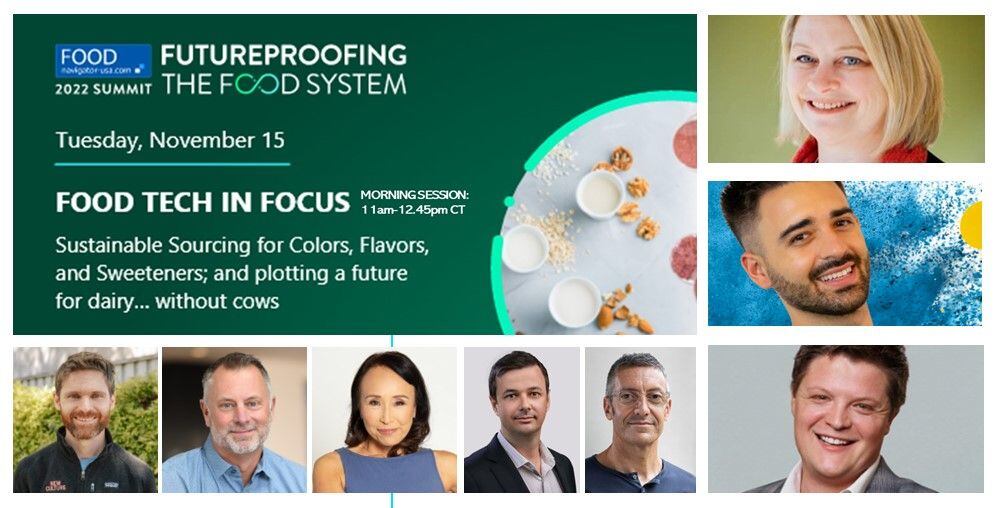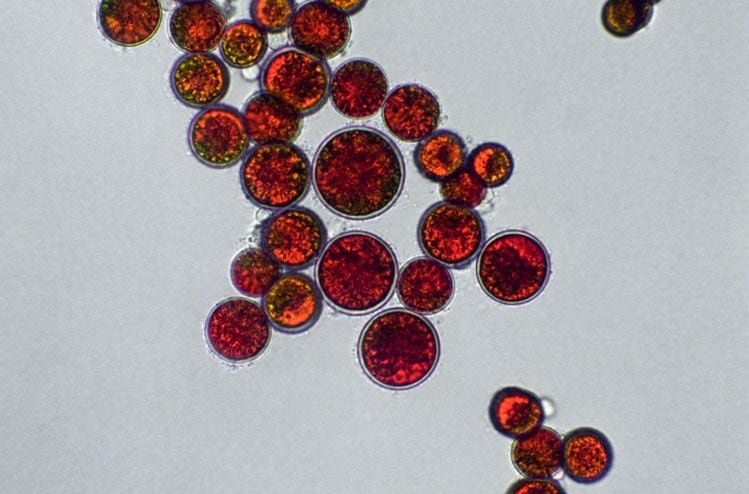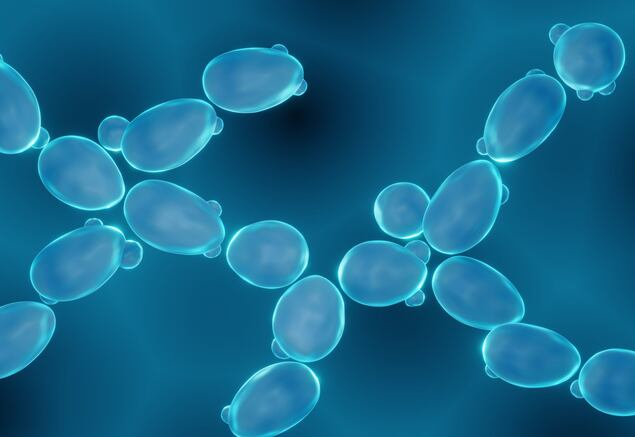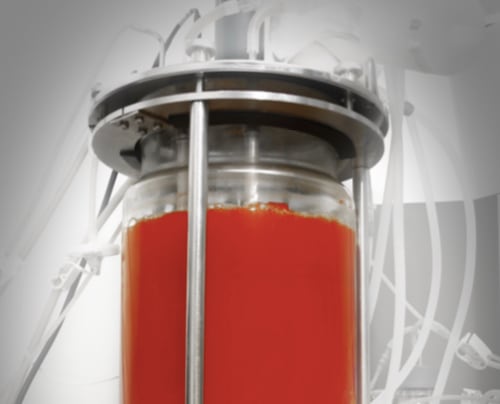A bright red carotenoid and powerful antioxidant used in multiple industries from food and nutrition to cosmetics and animal feed (representing the bulk of the $750 market in 2022), astaxanthin is primarily produced via chemical synthesis from petroleum derivatives.
However, several companies including Cyanotech, AlgaTech, BGG (Algae Health Sciences), Algalif, Valensa, Fuji Chemical (AstaReal), Atacama Bio Natural Products, and Piveg now produce commercial quantities of astaxanthin from the microalgae species Haematococcus pluvialis grown in big outdoor raceways/ponds or in photobioreactors (glass tubing outside in the sunlight).
While several firms have been developing yeast strains to produce astaxanthin including Israeli firm NextFerm and California-based Biomedican, it is still an emerging area, says Willow Bio, which has developed yeast strains that produce high purity astaxanthin bio-identical to that found in nature.
Like Biomedican, Willow started out producing cannabinoids such as CBG via microbial fermentation, but started exploring other functional ingredients given the challenging economics of cannabinoid production created by the ongoing regulatory impasse and price erosion from over-supply in the hemp extract market.
‘History showed us many strains that claimed such cost savings that worked well in the lab, but never could be scaled up’
But why make astaxanthin from yeast at all if you can extract it from microalgae?
“What we see in the market is that the attraction to customers is the ‘pure, consistent, and sustainable’ option, batch to batch consistency, and the ability to add only astaxanthin without other products found in the algae matrix,” CEO Peter Seufer-Wasserthal told FoodNavigator-USA.
“There will always be a market for both [astaxanthin from yeast and microalgae], but the trend for many products is to be the pure form that can be formulated as needed.”
It’s still early days, but Willow Bio has made significant progress, said Seufer-Wasserthal, who said Willow Bio’s astaxanthin is “expected to be sufficiently cost-effective to compete with the chemically produced product” and is also expected to be suitable for the food and nutrition and cosmetics markets, “which are currently served by low-purity, high-cost material produced using algae.”
Asked about others in the space producing astaxanthin using yeast strains, he added: “Ultimately production using fermentation with well-developed strains and processes can be very cost competitive. But this takes time to do and close collaboration between strain and process development, something that too often isn’t done well in our industry.
“In a large vessel, everything takes longer. You cannot get as much oxygen into the fermenter... and history showed us many strains that claimed cost savings that worked well in the lab, but never could be scaled up. At Willow we have proven scalability for one of our strains and processes.”
Simpler downstream process can dramatically increase the amount of astaxanthin recovered from the fermentation
While developing high-yielding bioengineered yeast strains is key to driving efficiency, a key differentiator for Willow is its downstream processing and purification techniques, which enable it to dramatically increase the amount of astaxanthin it is able to recover from the fermentation process, from around 30% in a traditional fermentation process to 90%, he claimed.
“We’ve changed an 11-step downstream process to a four step downstream process with a 90% yield.”
He added: “Ultimately, we will need to partner with somebody, we cannot produce it [at commercial scale] ourselves.”
Market opportunities
So what markets is Willow Bio going after?
According to Seufer-Wasserthal, “We will use a stepwise approach from the lower volume, higher price segments to ultimately the high volume areas. Purity has to be a given that we won’t compromise on. If we want to be successful, price always plays a major role. The form will depend on the use, one is not necessarily better than the other, different forms will have different applications.”
No detectible modified DNA in final product
So is the yeast strain Willow Bio is using genetically engineered, and if so will fragments of the host micro-organism be detectible in the astaxanthin such that it would trigger ‘bioengineered’ labeling in the US market?
According to Seufer-Wasserthal, “We are using genetically engineered strains, because only those will allow getting to the economics needed in a reasonable timeframe.” But he added: “Downstream processing and product purification will remove all DNA and protein to non-detectable levels allowing ‘natural’ designation.”
Cannabinoids via fermentation: ‘I am still hopeful about this market, but we can’t rely on it
Asked about the status of Willow Bio’s work on cannabinoids, he said: “We’ve done what we could do and developed a process we can scale up, so we are ready, we're just organizing our tech transfer to a large contract manufacturer and we plan to do a batch in the first half of next year.
“The size depends on the market. This issue in the market is not the commercial side needed to open up the market, it’s the political side, the regulatory side.”
In short, he said, “I am still hopeful about this market, but we can’t rely on it.”
Interested in the production of colors, flavors, sweeteners and nutraceuticals via precision fermentation?

Check out our upcoming digital summit, Futureproofing the Food System (Nov 15-17), which delves into precision fermentation on the opening session of day one: Food Tech in Focus:
MORNING SESSION (11am- 12.45pm Central time): Sustainable Sourcing for Colors, Flavors, and Sweeteners; and plotting a future for dairy… without cows
PANEL: Biosynthesis: Fermentation and the future of flavors, colors and sweeteners Does it always make sense to extract flavors, colors, sweeteners and other food ingredients from plants if you can produce them more efficiently - and more sustainably – via microbial fermentation, ‘cell-free’ approaches or plant cell culture?
- Dr Joshua Britton, founder and CEO, Debut Biotech
- Nusqe Spanton, founder and CEO, Provectus Algae
- Dr David Welch, CSO and co-founder, Synthesis Capital
- Ricky Cassini, CEO and co-founder, Michroma
- Dr Erin Marasco, global biology lead, Cargill
- MODERATOR: Elaine Watson, senior editor, FoodNavigator-USA
PANEL: Dairy 2.0: Plant-based milks now account for more than 15% of the fluid milk market, while plant-based cheese, creamers, yogurts and ice cream continue to gain traction. So where is the market going next, where’s the white space in the category, and what is the potential of a new wave of ‘animal-free dairy’ products made with real milk proteins and fats, minus the cows?
- Miyoko Schinner, founder and CEO, Miyoko’s Creamery
- Dave Ritterbush, CEO, Califia Farms
- Matt Gibson, co-founder and CEO, New Culture
- Sonia Huppert, global innovation marketing leader, re-imagine protein, IFF
- MODERATOR: Elaine Watson, senior editor, FoodNavigator-USA



